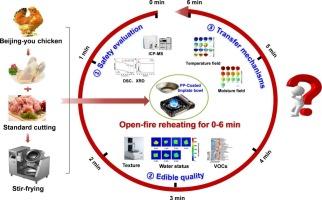涂覆马口铁碗包装的炒鸡在明火再加热过程中安全性和食用质量的变化:实验和可视化建模
IF 9.8
1区 农林科学
Q1 CHEMISTRY, APPLIED
引用次数: 0
摘要
由于包装材料的限制以及传热和传质机制的不明确,即食肉制品在加热过程中遇到了安全和质量方面的挑战。本研究结合实验和模拟计算,研究了涂层马口铁碗中的炒鸡胸肉在明火加热(0-6 分钟)过程中的安全性、质地、水分状态和风味特征的变化。6 分钟后,涂层马口铁碗中重金属元素的迁移仍在安全范围内。明火加热对聚丙烯薄膜的热稳定性和晶体结构造成了轻微破坏。炒鸡胸肉在 5 分钟后硬度(5.43 N)和咀嚼度(1226.13 N)最低,而在 6 分钟时弹力值(0.46 mm)最低,这与挥发性有机化合物浓度的峰值相吻合。在后期阶段(4-6 分钟),热渗透的增加加速了水分的迁移,显著增加了游离水含量(P < 0.05)。此外,"爆炒鸡胸肉涂层马口铁碗 "可视化模型有效地验证了爆炒鸡胸肉在重新加热过程中的温度和水分状态。总之,这种综合方法为了解使用涂层马口铁碗包装的即食肉制品在明火加热过程中的质量变化提供了有价值的见解。本文章由计算机程序翻译,如有差异,请以英文原文为准。

Changes in the safety and edible quality of stir-fried chicken packaged using coated tinplate bowls during open-fire reheating: Experimental and visualization modeling
Due to limitations in packaging materials and unclear heat and mass transfer mechanisms, ready-to-eat meat products encounter safety and quality challenges during reheating. This study combined experimental and simulation calculations to investigate changes in safety, texture, water status, and flavor profile of stir-fried chicken breast meat in coated tinplate bowls during open-fire reheating (0–6 min). The migration of heavy metal elements from the coated tinplate bowls remained within safe limits after 6 min. Open-fire reheating caused slight damage to the polypropylene film's thermal stability and crystal structure. The stir-fried chicken breast meat exhibited the lowest hardness (5.43 N) and chewiness (1226.13 N) after 5 min, while the lowest springiness value (0.46 mm) was observed at 6 min, coinciding with peak volatile organic compound concentrations. Increased heat penetration during the later stages (4–6 min) accelerated water migration, significantly increasing free water content (P < 0.05). Furthermore, the “Stir-fried chicken breast meat-coated tinplate bowl” visualization model effectively validated the temperature and water status of stir-fried chicken breast meat during reheating. Overall, this integrated approach provides valuable insights into the quality changes of ready-to-eat meat products packaged using coated tinplate bowls during open-fire reheating.
求助全文
通过发布文献求助,成功后即可免费获取论文全文。
去求助
来源期刊

Food Chemistry
工程技术-食品科技
CiteScore
16.30
自引率
10.20%
发文量
3130
审稿时长
122 days
期刊介绍:
Food Chemistry publishes original research papers dealing with the advancement of the chemistry and biochemistry of foods or the analytical methods/ approach used. All papers should focus on the novelty of the research carried out.
 求助内容:
求助内容: 应助结果提醒方式:
应助结果提醒方式:


